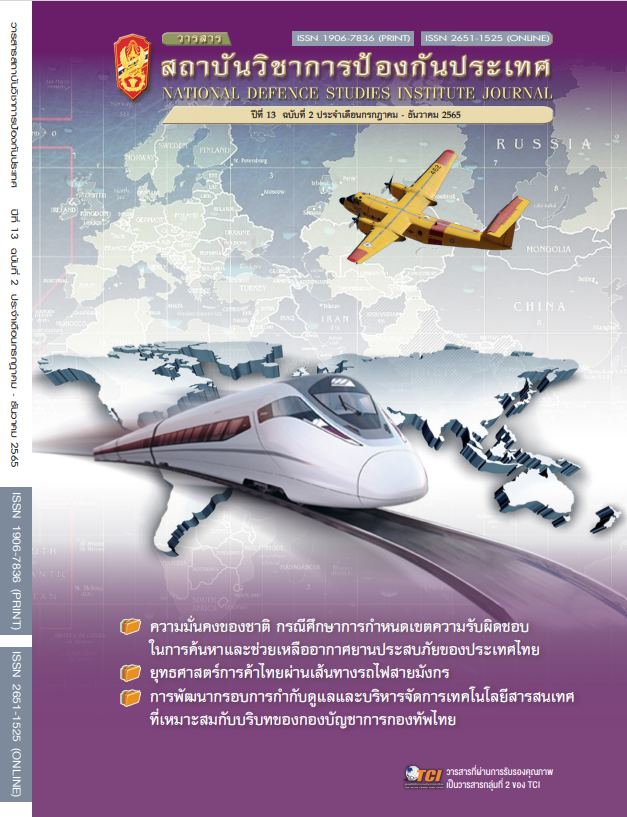Development of a Multilevel Structural Equation Model of Factors Influencing Learning and Innovation Skills
Main Article Content
Abstract
This research aimed to examine the causal model of student levels and class levels with students’ learning skills and innovation. The samples, obtained through multi-stage random sampling, were divided into two groups: 1) 893 students as the samples for the analysis of student level factors and 2) 78 teachers as the samples for the analysis of class level factors. The instruments were a questionnaire for students and a questionnaire for teachers. Statistical data were analyzed using SPSS22.0, and the Multilevel Structural Equation Model (MSEM) was analyzed using Mplus 8.8.
The result revealed that the Multilevel Structural Equation Model (MSEM) affecting students’ learning skills was consistent with the empirical data (Chi-square = 86.903, df = 71, p-value = 0.0966, and RMSEA = 0.016). Examining the causal model of the student level factors, the research found that democratic parenting, students’ attitude and internal locus of control towards learning had positive effect on students’learning skills and innovation. In addition, democratic parenting was found to be statistically significant, indirectly affecting students’ learning skills and innovation through their internal locus of control. Examining the causal model of class level factors, the result was statistically significant, revealing that learning activities and classroom atmosphere had positive impact on students’ learning skills and innovation. Both factor groups could explain students’ learning skills with a variance of 71% and explain students’ innovation with a variance of 95%.
Article Details

This work is licensed under a Creative Commons Attribution-NonCommercial-NoDerivatives 4.0 International License.
The articles, images, tables, graphs, written content, and opinions published in this journal are solely those of the authors and do not necessarily reflect the views or positions of the National Defence Studies Institute or its academic affiliates.
References
กรมการจัดหางาน. (2560). ยุทธศาสตร์ การแก้ไขและป้องกันการขาดแคลนแรงงาน พ.ศ.2560-2564. สืบค้นจากhttps://www.doe.go.th/prd/assets/upload/files/lmia_th/498391d8154f6237d5db6b423d5f1b85.pdf
กรณ์กาญจน์ นนพัชรพงศ์ และบุญมีพันธ์ไทย. (2559). ปัจจัยที่มีอิทธิพลต่อการคิดอย่างมีวิจารณญาณของนักเรียนมัธยมศึกษาตอนปลายในโรงเรียนมาตรฐานสากลเขตภาคเหนือ. วารสารดุษฎีบัณฑิตทางสังคมศาสตร์, 6(2), 124-134.
กระทรวงศึกษาธิการ, สำนักงานปลัดกระทรวงศึกษาธิการ, สำนักงานศึกษาธิการ ภาค 12, กลุ่มยุทธศาสตร์การศึกษา. (2562). รายงานผลการดำเนินงานโครงการประชุมปฏิบัติการสร้างการรับรู้การขับเคลื่อนเป้าหมายการพัฒนาที่ยั่งยืนด้านการศึกษา ในระดับพื้นที่ ประจำปีงบประมาณ พ.ศ.2562. สืบค้นจาก http://www.reo12.moe.go.th/web/images/supply/Report-SDG.pdf
กัณหา เทพดุสิต. (2554). ปัจจัยที่มีอิทธิพลต่อความสามารถในการคิดวิเคราะห์ของนักเรียนชั้นมัธยมศึกษาปีที่ 3 สำนักงานเขตพื้นที่การศึกษาจังหวัดอุดรธานี: การวิเคราะห์กลุ่มพหุ (วิทยานิพินธ์ปริญญาศึกษาศาสตรมหาบัณฑิต). มหาวิทยาลัยมหาสารคาม.
กัลยา สร้อยสิงห์. (2563). ปัจจัยที่ส่งผลต่อทักษะการเรียนรู้และนวัตกรรมในศตวรรษที่ 21 ของนักศึกษาวิทยาลัยดุสิตธานี. วารสารวิทยาลัยดุสิตธานี, 14(2), 486-501.
ฉัตรติยา ลังการัตน์. (2560). โมเดลความสัมพันธ์เชิงสาเหตุปัจจัยที่ส่งผลต่อความคิดสร้างสรรค์ทางศิลปะของนักเรียนชั้นมัธยมศึกษาปีที่ 3 จังหวัดระยอง (วิทยานิพนธ์ปริญญาศึกษาศาสตรมหาบัณฑิต). มหาวิทยาลัยบูรพา.
ชมพู โกติรัมย์. (2555). ศตวรรษที่ 21 ปัจจัยการผลิตที่ท้าทายก้าวย่างที่ต้องปรับของไทย. สืบค้นจาก http://dspace.spu.ac.th/handle/123456789/3866
ธนกฤตา แจ่มด้วง. (2560). แนวทางการพัฒนาทักษะการเรียนรู้และนวัตกรรมของนักศึกษามหาวิทยาลัยศิลปากรตามนโยบายประเทศไทย 4.0. วารสารวิทยาการจัดการ มหาวิทยาลัยราชภัฎนครปฐม, 5(2), 146-160.
ประทีป คงเจริญ. (2564). ทักษะการเรียนรู้และนวัตกรรม: คุณลักษณะสำคัญของพลโลกในยุคเศรษฐกิจที่ขับเคลื่อนด้วยนวัตกรรม. วารสารมนุษยศาสตร์และสังคมศาสตร์มหาวิทยาลัยธนบุรี, 15(3), 165-177.
พิมพันธ์ เดชะคุปต์. (2544). บรรยากาศการเรียนการสอน : ปัจจัยสำคัญต่อประสิทธิภาพการสอน. วารสารมิตรครู, 32(12), 10-14.
วรรณิกา คูณภาค. (2560). ตัวแปรที่ส่งผลต่อความคิดสร้างสรรค์ของนักเรียนชั้นมัธยมศึกษาปีที่ 3 สังกัดสำนักงานเขตพื้นที่การศึกษามัธยมศึกษา เขต 29 (วิทยานิพินธ์ปริญญาครุศาสตรมหาบัณฑิต). มหาวิทยาลัยราชภัฏอุบลราชธานี.
ศิริรัตน์ จำแนกสาร. (2563). หลักการวิเคราะห์โมเดลสมการโครงสร้างพหุระดับโดยใช้ขนาดตัวอย่างและวิธีการประมาณค่าที่เหมาะสม. วารสารการวัดประเมินผล วิจัยและสถิติทางสังคมศาสตร์, 1(1), 12-20.
อรณิชชา ทศตา และกชพร ใจอดทน. (2563). ปัจจัยที่ส่งผลต่อความคิดสร้างสรรค์ของนักศึกษาระดับปริญญาตรี วิทยาลัยนครราชสีมา. วารสารวิชาการสมาคมสถาบันอุดมศึกษาเอกชนแห่งประเทศไทย (สสอท.), 26(2), 64-78.
Bandura, A. (1986). Fearful expectations and avoidant actions as coeffects of perceived self-inefficacy. American Psychologist, 41, 1389-1391.
Hair, J. F., Black, B., Babin, B., Anderson, R. E., & Tatham, R. L. (2006). Multivariate data analysis (6th ed.).New Jersey: Pearson Prentice Hall.
Hox, J. J. (2010). Multilevel Analysis: Techniques and Applications (2nd ed.). New York: Routledge. Partnership for 21st Century Skills. (2019). framework for 21st century learning definition. Retrieved from https://www.battelleforkids.org/networks/p21/frameworks-resources
Roger, D. (1972). Issue in Adolescent Psychology. New York: Meredith Corporation.
Rosenberg, M. J. & Hovland, C. I. (1960). Cognitive, Affective and Behavioral Components of Attitudes. In Rosenberg. M.J. and Hovland, C.I. (Eds.), Attitude Organization and Change: An Analysis of Consistency among Attitude Components. London: Yale University Press.
Rotter, J. B. (1966). Generalized expectancies for internal versus external control of reinforcement. Psychological Monographs: General and Applies, 80(1), 1-28.
United Nations. (2018). Goal 4: Ensure inclusive and quality education for all and promote lifelong learning. Retrieved from https://www.un.org/sustainabledevelopment/education/


